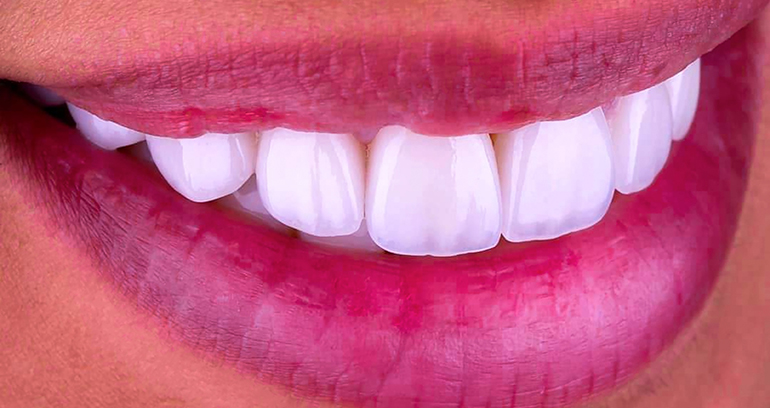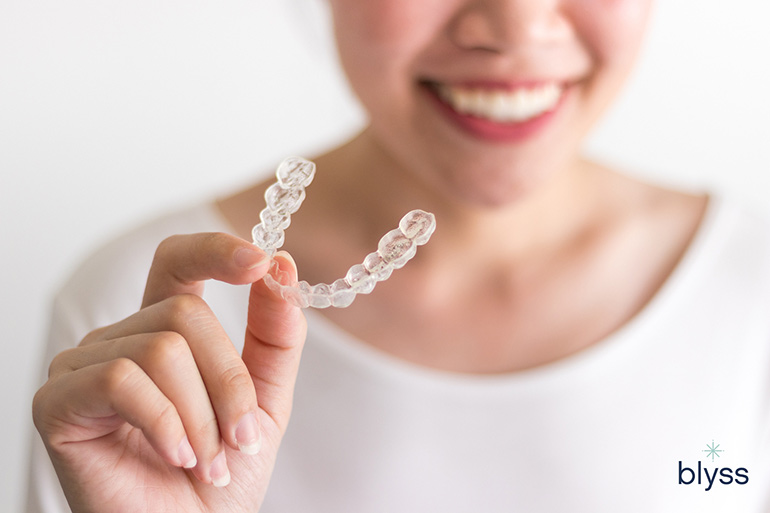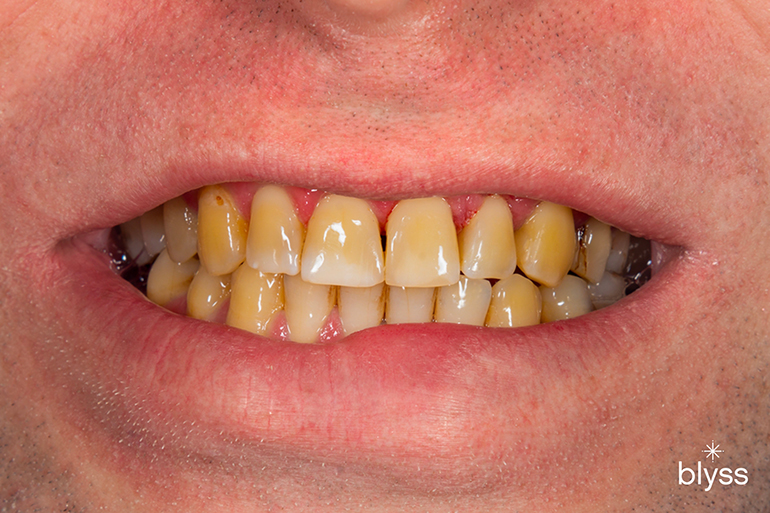lay outPerfect pearly whites are all over social media. You might think about how these people got so lucky to have really nice white teeth. Well, don’t be fooled! Most “perfect” teeth that you see are what we call veneers.
Here at Blyss Dental, we help patients from Del Mar and San Diego to achieve that perfect smile. But, before you hop into your car and go to the dental office, I’d like to first guide you on everything you need to know before getting veneers.
With this article, I’ll help you achieve the following goals:
- Get it right the first time to avoid issues, hassles, and regrets;
- Have the best possible outcome;
- Understand if veneers are really right for you;
- Communicate clearly with your dentist on what you really want;
- Choose the best dentist for veneers; and,
- Get the most value out of your money
What Are Veneers?
Veneers are used to instantly correct imperfections in your teeth – from the color up to the shape of your smile. Veneers are customizable depending on what you want to achieve.
Thin shells made up of resin or ceramics (such as porcelain veneers), veneers are shaped like the front surface of your teeth. They are then glued on top of your natural teeth like a mask or laminate. This gives you the instant perfect smile right after the cosmetic dentistry procedure.
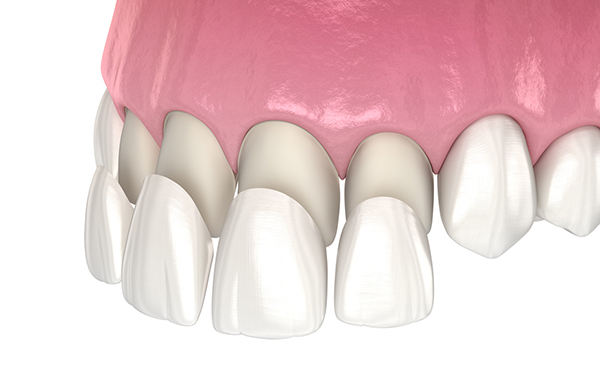
Veneers are thin devices glued on top of the natural teeth to cover up imperfections.
People in show business, beauty pageants, and social media (influencers) who are always in the limelight usually have veneers because having the “perfect Hollywood smile” gives out that extra glow instantly.
Even if you just want to try it out to have that extra boost of confidence, or want to go all-in in getting that Hollywood smile, there are several material options to choose from that would surely fit you.
1. What Is Teeth Reduction And Is It Necessary For Veneers?
In order to get veneers, tooth reduction might be necessary. This is the one procedure that most people looking into getting veneers usually ask about.
Tooth reduction means reducing a part of your natural teeth or the outermost layer of your teeth so the veneer can “sit” properly on your tooth. The amount of tooth structure that will be reduced will depend on your teeth’s natural state and the smile you want to achieve.
Insufficient tooth reduction can result in poor stability of your veneers. It could also result in veneers being too bulky or too thick. This is why planning or discussing the result you want with your dentist is very important.
Is teeth reduction painful?
Depending on the level of reduction, your dentist might need to numb off your teeth first so you’ll be more comfortable during the procedure. You might feel “thickness” on your lips or gums but the effect is only temporary. This might be done at every appointment depending on your level of pain tolerance.
When is it necessary to do teeth reduction?
I listed below the most common reasons when dentists recommend reducing your teeth:
- Uneven teeth size. Having the perfect smile means having teeth that are symmetrical and proportioned. Reducing the teeth will give space for the veneers to be uniform on both sides and match your smile.
- Crooked teeth. Crooked or crowded teeth mean your teeth do not have enough space. Braces usually fix this, but if you want faster results, veneers are the way to go.
- Heavily stained teeth. Systemic factors which developed in the womb (also known as tetracycline stains) can cause this. This results in deep discolorations in your teeth which require more tooth reduction to cover up.
- Teeth with cavities. Having cavities means removing the decayed part of your teeth. This will give enough room for a restoration that could be composite or porcelain.
- Fluorosis. Having too much fluoride in the body causes these white spots. They may appear like chalky-white spots in your teeth and sometimes have small holes in them.
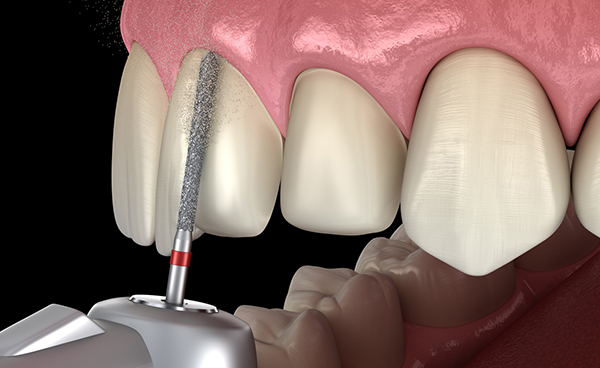
Teeth reduction might be a necessary process before getting veneers.
How much tooth reduction is necessary to get perfect veneers?
Recent studies have shown that a lesser amount of tooth structure removed has more benefits. This includes Veneers sticking better to the tooth and having lesser chances of breaking or chipping off. There are also lower chances of getting post-operative teeth sensitivity with less tooth reduction.
But, depending on the correction needed, some dentists still prefer more tooth reduction.
More tooth reduction will give your dentist and dental technician plenty of room to modify or play around with the layers to make the veneers more natural-looking. This may also apply to people who need orthodontic treatment but don’t really want to wait for at least 18 months.
Although this was the first technique used in making Veneers, removing too much healthy tooth structure means deeper areas of the teeth will be exposed that need to be covered by the veneer. If not sealed properly, there are higher risks of post-operative sensitivity or cavity formation which may eventually lead to further problems needing root canal treatment.
But always remember that there’s still nothing stronger than your natural tooth structure. Although getting veneers will give you the perfect smile, it will not make your teeth “indestructible”, so make sure to follow the correct post-operative care.
A. Levels Of Teeth Reduction
Your dentist may recommend an appropriate level of teeth reduction depending on your case or what you want to achieve with your veneers. I outlined the three levels of teeth reduction below to give you a headstart on one of the most important things to discuss with your dentist.
Level 1: Traditional Tooth Reduction
Traditional tooth reduction involves removing a large portion of your teeth including the enamel or the topmost layer. Sometimes, this may also include the dentin which is the next layer of the teeth.
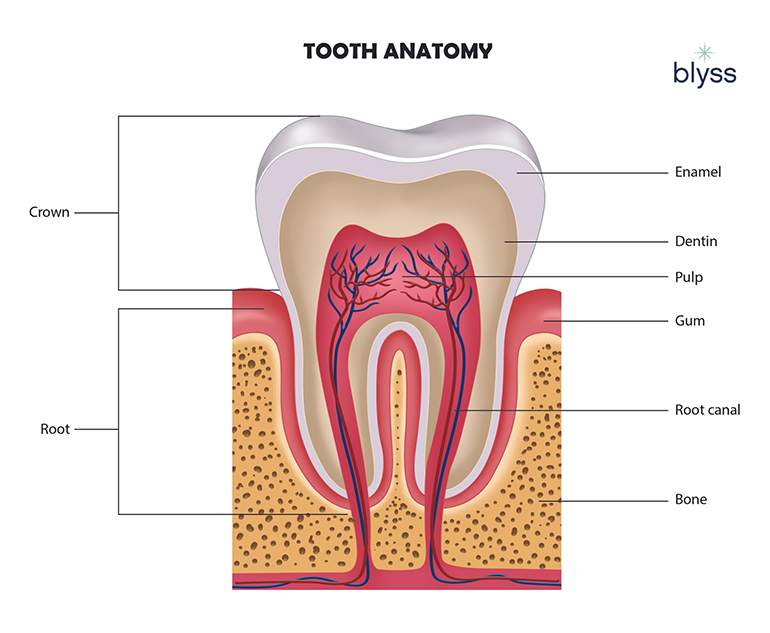
Level 1 tooth reduction removes a large portion of the tooth’s enamel and sometimes reaches the dentin.
More reduction means the veneers will be thicker. Back in the day, it was commonly believed that a thicker veneer was stronger and less resistant to breaking. However, this is not always the case since the natural teeth structure can be compromised due to over-reduction.
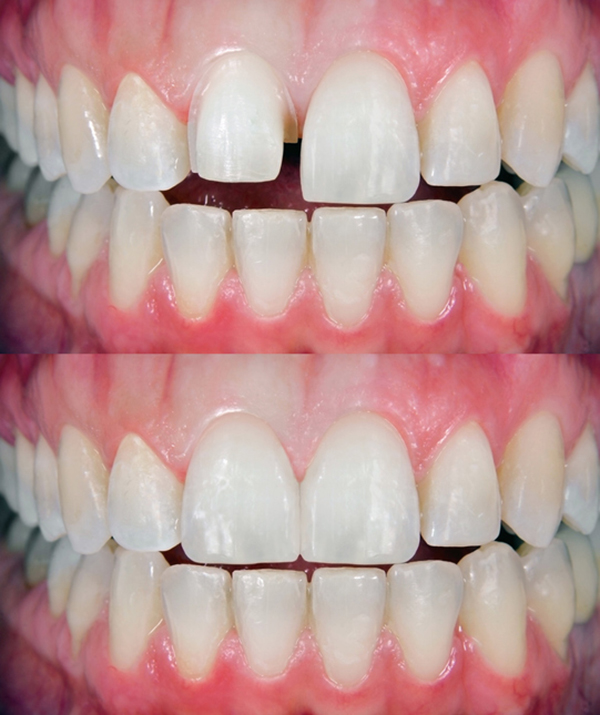
Traditional tooth reduction removes a large portion of your tooth’s enamel.
At Blyss Dental, we avoid Level 1 tooth reduction. But of course, this depends on your case such as when you have severe crowding or teeth discoloration.
Level 2: Minimal Preparation Veneer
In Level 2 teeth reduction, dentists will only reduce certain areas of the teeth. Oftentimes, the reduction is less than 0.5 mm and is most likely confined in the enamel area only.
This level of reduction is done to preserve as much tooth structure as possible. Studies show that veneers that are bonded in the enamel area have stronger retention compared to those that reach the dentin area.
Compared with enamel, dentin is not that strong to withstand the forces of the veneers, especially thick ones. With the right adhesive, veneers bonded with the enamel are stronger and more durable which means lesser chances of chipping off.
Level 3: No-Prep Veneers
This level of teeth reduction is a fairly new technique but is mostly preferred by patients. Why? Because there will be no reduction of the natural teeth.
Since there is no tooth reduction, the veneer is only held by the adhesive. This is commonly used with resin materials or on minor teeth corrections like making the teeth longer, rounder, or squarer in just one visit.
The good thing about this level of reduction is that it is reversible since no natural tooth structure is removed. The biggest disadvantage is that not many people are candidates. No prep veneers can give you limited results depending on the corrections needed.
B. How Do Dentists Decide On The Right Level Of Teeth Reduction For You?
Before asking your dentist for minimal or no-prep veneers, make sure that your dentist thoroughly assesses your case first.
Here are the things that your dentist may consider before reducing your teeth (or not):
- Your current bite. Crooked teeth might be the reason why you are considering getting veneers. But if you want to have minimal or no-prep veneers, you might need to have orthodontic treatment first which means braces or aligners.Once your teeth are perfectly aligned and your bite is stable, your dentist can now consider minimal or no-prep veneers since the corrections will now be minimal. But if you really refuse orthodontic treatment, traditional tooth reduction can still be considered.
- Smile design. Smile design is like an instant photoshop of your teeth where your dentist can customize the shape, color, and size of the veneers and instantly place it on your photo. From this, your dentist can somewhat see how much tooth reduction is needed to achieve the perfect smile.
- Provisional veneers. Once we get that perfect smile, your dentist will get molds of your teeth and fabricate provisional veneers. This can be placed on top of your natural tooth where you will be able to feel and see what your perfect smile would actually look like even without teeth reduction.
“Shawn, whose teeth are in great shape, has discolored teeth due to medications he had to take when he was young. He wanted no-prep veneers, but the dentist said the thin and translucent veneer will still show the discolored teeth. So, the dentist said he would have to do traditional tooth reduction and reduce more tooth structure to create a natural-looking smile with translucency.”
2. What Type Of Veneer Is Ideal For You?
Now that you know the basics about veneers and teeth reduction, the next important question to ask is what type of veneer best suits you.
To find out which material you should get, you first need to identify what you want to achieve, how committed you are to multiple dental appointments, and most importantly, how much you are willing to invest.
The two main types of veneers are composite and ceramic.
A. Composite Veneers
What Are Composite Veneers?
Composite veneers use composite resin like the material used in your fillings or restorations on your back teeth. Also known as direct veneers, they are fabricated chairside or directly done on your teeth.
Here are some pros and cons of composite veneers to consider if this is the right choice for you:
Pros
- Composite resin is way cheaper than ceramics. If you want to have a smile makeover but only have a working budget, this is for you. You can easily revamp your smile by just starting with at least your two front teeth.
- No multiple visits to your dentist. Composite veneers will give you instant results on the same day. Since composite resin is manually manipulated by your dentist, you can tell your dentist what you want to achieve, and your dentist can modify it on your teeth instantly.
- No need to wear temporary veneers. After your dental appointment, you can instantly flash off your new smile. You don’t have to worry about wearing temporaries which can pop off anytime. Some temporaries also do not look as nice if not done meticulously and it can also incur additional costs to your treatment.
- Composite veneers are easily repairable. Composites are available in all dental offices. So, if you accidentally break or chip off your composite veneer, you can easily go to your nearest dental office to have them fixed right away.But you still need to go back to your original dentist to check what went wrong. It’s good to know though that any dentist can fix it instantly should emergencies happen. We guarantee our veneers for 5 Years at Blyss Dental, call us to schedule a free consultation.
- Dentists can make adjustments. This means that there’s no need to resend the veneers to the lab if you want them reshaped or to change the color. Your dentist can easily adjust it on the same appointment.
- Less invasive. Most composite veneers require minimal to no tooth reduction which means more natural tooth is retained. Lesser tooth reduction also lowers the risk of post-operative sensitivity.
- More natural-looking than ceramic veneers. Color or shades of composites are more translucent and not as opaque or solid as ceramics, which can be more aesthetic. You can easily achieve a new smile without it looking too “fake” or too “perfect”.
- Perfect for younger patients. Younger patients are great candidates for composite veneers since it requires minimal teeth reduction and are most likely reversible. Frequent breakage is also common in younger patients which will require more repairs.Repair of composite veneers is way cheaper and faster compared with ceramic veneers. For example, they can get composite veneers “temporarily” until they are older and ready for porcelain veneers.
Cons
- Less longevity and durability. Composites are less strong than ceramics, so their lifespan can also be shorter. They can last from 3-6 years depending on how you take care of them. Your composite veneers are less likely to stay pristine for a long time if you are not cautious with what you bite or eat.
- Not ideal for every case. Composites may not work for you if you have major teeth discoloration or abrasion. Major discolorations may require more teeth reduction in order to mask the original color.This means using something more opaque or solid which composites might not deliver. Also, grinded teeth will require something stronger which can withstand the grinding forces of the teeth along with treating the cause of the grinding.
- Not all dentists are trained or like to do composite veneers. Composite is easily available but it requires meticulous work because of manual manipulation on a tooth directly inside the mouth. Your dentist needs training on composite installation, shade selection, and tooth anatomy design.
- Color of composites will not be permanent. Composites stain with time especially if you have certain habits like smoking, drinking tea, coffee, or wine, and eating food with strong colors like tomato sauce, turmeric, and curry.This means coming in at least every 6 months for polishing. Your dentist may use a jet polisher or fine grit discs or burs to polish the surface. Eventually, composite veneers will need refilling after repeated polishing.
- Long dental appointment. Although you can get your smile instantly, you should prepare for the long hours on the dental chair since it might take a while to get the perfect veneers.
Who Should Get Composite Veneers?
To summarize the pros and cons above, composite veneers are perfect for you if:
- You want instant results;
- Don’t have time for multiple dental visits;
- Want to try out having veneers without too much reduction of your natural teeth;
- Have a limited budget but want a new smile; and
- Need to look nice for an event or shoot.
B. Ceramic Veneers
What Are Ceramic Veneers?
Ceramic veneers can be made up of porcelain, lithium disilicate, or zirconia. Unlike composite veneers, ceramists make ceramic veneers in a dental laboratory which is why they are also called indirect veneers. The most common types of ceramic veneers are porcelain and Emax.
Your dentist would need to assess your teeth to know which type of ceramic will suit you better. Zirconia veneers are best for teeth grinders because they are stronger. However, they don’t have the same natural translucency as Emax (lithium disilicate) veneers.

Emax and zirconia are the most common materials used for ceramic veneers.
Like composite veneers, there are several pros and cons to consider:
Pros
- Stronger and can last longer than composite veneers. You could expect that your ceramic veneers can last up to 10 to 15 years, or even longer depending on how you take care of them. But, you still need to visit your dentist at least twice a year and also have your x-rays taken to monitor your teeth and bone level.
- Ceramic veneers are more durable. You still have to be extra careful, though, and avoid putting too much force on your front teeth or using it to tear open your snacks!
- More room to manipulate the color and shade. Ceramic veneers are fabricated in the laboratory which means there is more room for customization.A masking layer can easily be added to make sure those dark or gray areas of the teeth are covered completely which is not possible with composites. Whether you want to have ultra-pearly whites or just natural-looking veneers, it can be easily achieved with ceramics.
- Perfect for more complex cases. Since this is fabricated outside the mouth or in the dental laboratory, multiple units or teeth can be done with more uniformity and symmetry. This can address severe cases of crowding or spacing and can be more aesthetically pleasing.
- Trial fitting is possible. Ceramic veneers have layers that need to be tried on before cementing or gluing it permanently on your teeth. You get to see them in your mouth starting from the first layer, to check if margins are properly sealed, up to the final glazing which shows the result of the veneer.
- No tooth reduction is possible. There are now no-prep veneers available wherein tooth structure does not have to be reduced. These are usually “contact lens” thin veneers or ultra-thin veneers. This will not give you the feeling of bulky teeth which can take some time to adjust to.
- No staining. Ceramic veneers have that final “glazing” which also seals off the surface of the veneer. This closes off the porous surface and will prevent stains from sticking easily and alter the layers of porcelain. You wouldn’t have to worry about stains from your tea or wine.
Cons
- They cost more. Since you will normally need anywhere from 6 to 12 per arch to transform your smile, expect that you’ll need to invest more when getting ceramic veneers
- There is no turning back. Once your natural teeth are reduced, there is no more turning back. This means that if you realize one day that you don’t want to have veneers anymore, you can never have your natural teeth back. But most people don’t regret getting cosmetic dental work unless you had bad results from an unqualified dentist.
- Ceramic veneers require more time, commitment, and patience. You will need to give ample time for the dental laboratory to fabricate your veneers. They might also have to go back to the dental laboratory for adjustments, so expect multiple dental visits with several days of interval.
- Replacement is costly. It is still possible to break or chip off. When this happens, you’ll have to replace the entire veneer completely. There are “porcelain repair kits” available in some dental offices but this will only be a temporary fix.
- Higher risk for dental issues. Reducing your natural teeth might increase the risk for cavities, post-operative sensitivities, or root canal treatment. If the margins between the tooth and the veneer are not properly sealed off or will have leaks, bacteria can enter and cause more problems.
- Existing dental problems should be addressed first. Ceramic veneers might cause further problems if veneers are made but other problems in the mouth are not addressed like periodontal or gum problems. Veneers might aggravate them and might have a poor prognosis if not addressed correctly.
Who Should Get Ceramic Veneers?
So why are ceramic veneers perfect for you?
- Want to achieve the best smile makeover;
- Have severe corrections needed to be done on your teeth;
- Don’t want to worry about your veneers chipping off;
- You drink coffee, tea, and wine every day; and,
- You want an ultra-pearl white Hollywood smile.
What Are The Types Of Ceramic Veneers?
The most common ceramic veneers used nowadays are made with zirconia or lithium disilicate (commonly known as Emax veneers).
Depending on what you want to achieve, your veneer could also be monolithic. This means using only one block of the material without adding a layer of porcelain on top which gives out a more solid-colored-looking veneer. Cosmetic dentists usually add porcelain to the top layer to achieve a more natural-looking veneer.
- Lithium disilicate or Emax. These give out the most natural-looking or more aesthetic veneers. They cost less than zirconia but are not as durable. This material is commonly for 6-12 units of veneers.
- Zirconia. Although you need to shell out more, zirconia is the strongest ceramic available. This is best for patients who are grinders and require full mouth veneers or up to 20 units of veneers.
What Type Of Veneer Is Best For You?
To further help you in deciding what type of veneer to get, use this simplified table summarizing all the things you need to know about the two types of veneers.
| Composite Veneer | Ceramic Veneer | |
|---|---|---|
| Results | Instant; can be done on a single visit Longer dental appointment may be required depending on how many teeth or units will be made | It may take multiple visits before the result is seen Temporary or provisional veneers will be used while waiting |
| Material | Composite resin | Emax (lithium disilicate) Zirconia Porcelain |
| Also known as | Direct veneers | Indirect Veneers |
| Durability | At most 6 years May break if bite is forceful | At most 15 years More durable |
| Color/Appearance | More translucent and natural-looking May have more imperfections since manually adjusted by the dentist | More uniformity in color, size and shape You can achieve that “perfect Hollywood smile” |
| Price per unit | $770 to $1,100 | $1,500 to $2,700 |
| Where is it made | Chairside at the dental office Made directly on your teeth | Dental laboratory (in-house or third party) |
| Maintenance | Easily repairable; can be done/adjusted by any dentist Regular cleaning is required (every six months) | Once it breaks, the whole veneer should be replaced Regular cleaning is required (every six months) |
| Staining | May stain | Does not stain easily |
| Tooth Reduction | Minimal to zero tooth reduction More natural tooth is retained | No reduction to thicker reduction as required |
| Post-operative sensitivity | Low risk | Higher risk |
| Is it reversible? | Reversible depending on tooth reduction | Irreversible |
| Who can get it | People with minor tooth problems (discoloration, abrasion) Younger patients | People with major tooth discoloration, abrasion, crookedness, crowding/spacing People who want the “Hollywood smile |
3. How To Choose The Best Dentist To Work On Your Veneers?
There are various resources to research which dentist you should go to. Below are a few tips you might want to consider in choosing the best dentist for your veneers:
- Look into various dentists’ past works. You can see the work of some dentists in their social media accounts which act like their portfolio or a lookbook. If you like what you see, then that is a good sign to follow. However, not all things you see online may be true so be very careful about that.
- Communication is key. Make sure that you can comfortably communicate or talk to your dentist about what you want to achieve, and your dentist should understand that.
- Observe the dentist’s work habits. Since you and your dentist will be spending a lot of time working together, pay attention to what your dentist does at every appointment. You wouldn’t want a dentist who is always in a rush and doesn’t even pay attention to your opinions.
- Transparency on options. Your dentist should be able to give you several options for your case. Although he might recommend one best option, your dentist should be able to layout all your other options and the pros and cons for each one so you can also weigh in on what you prefer.
- Transparency on cost. Your dentist should also consider working around your budget and be upfront on the charges. Do not be afraid to “shop” or look for other dentists if you feel there is overselling.
- Consultation and assessment. Ask your dentist if you have other teeth problems to address first like cavities or wisdom teeth removal and don’t just focus on the aesthetics part. What good would a perfect smile do if you have infected molars or gum problems?
“Not everyone qualifies to get veneers right away. Sometimes, you have to fix other dental issues such as balancing your bite to ensure your investment in veneers won’t fail.
For instance, Jeremy’s front teeth have decay and heavy staining and he is looking forward to fixing his smile. His friend got porcelain veneers and the result was amazing, so Jeremy went to a cosmetic dentist and asked about porcelain veneers. The dentist recommended crowns on his molars because his molars have decay and are badly worn. The dentist needed to balance his bite so his porcelain veneers won’t fail. He also has a missing section on his upper jaw that needed a dental implant.
He insisted that he only wants work on his front teeth. His dentist, being ethical, declined his request because she knew the cosmetic dental work on the front teeth will fail without first balancing his bite through crowns on the molars.”
4. How To Discuss Veneers With Your Dentist
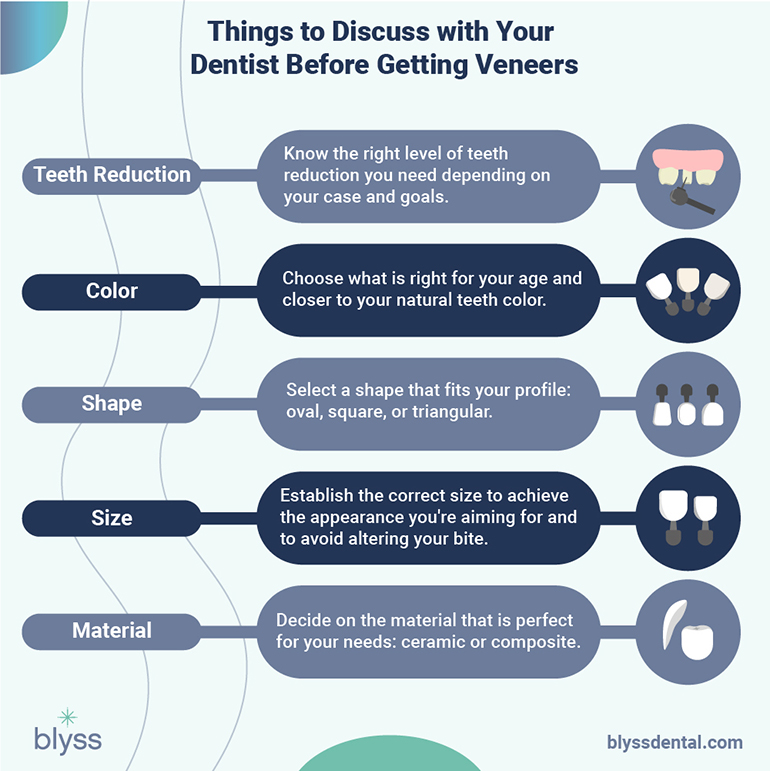
Once you’ve chosen a dentist, here are some points to discuss with your dentist before starting the procedure itself:
A. Goals: Why Do You Want Veneers?
Most people get veneers because they want to correct, improve, or enhance how they look to boost their self-confidence or some just want to have a smile to flaunt and be a social media star.
Some common “problems” that people want to correct or get rid of are:
- Small or uneven sized teeth
- Stained teeth which developed congenitally or due to habits
- Crooked, misaligned, or spaced-out teeth
- Gummy smile which exposes or show too much of the gum area on the upper arch
- Chipped teeth whether from trauma or abrasion over time
B. Setting Your Expectations
Although getting veneers will give you a smile makeover, not all teeth will be a good candidate and have the best outcome. Yes, it is easy to tell your dentist to copy the smile of your favorite celebrity. But, will it suit you?
For instance, many patients want to copy Blake Lively’s smile. Blake has proportionate gums, teeth, and lips. If you have fuller lips or if you have a gummy smile, copying Blake’s smile may not be appropriate since you may need a gum lift or recontouring.
Depending on the natural state or your natural teeth, the outcome may vary since no two teeth are exactly the same and you might need additional procedures like gum surgery or restorations to achieve your natural smile.
So, it is really important that you set your expectations realistically to be able to achieve an outcome that can satisfy you.
C. Veneer Color: Ultra White Or Natural?
Today, what we see on various media greatly influences the idea of a perfect smile. This affects most patients’ decisions on what veneer color they want to get.
The most common teeth color that we see on celebrities and influencers is super white which seems to be a trend, especially in Hollywood. Many people want to achieve that. However, is ultra-white the right color for you?
You should know that ultra-white may look unnatural, and people may notice right away that your teeth are not “real”. Bleach white teeth could be perfect for those into social media, modeling, or always in front of the camera.
If you want a perfect, natural-looking smile, you need to understand that naturally, our teeth are not really white. So, your veneers should closely resemble the natural color structure of your teeth.
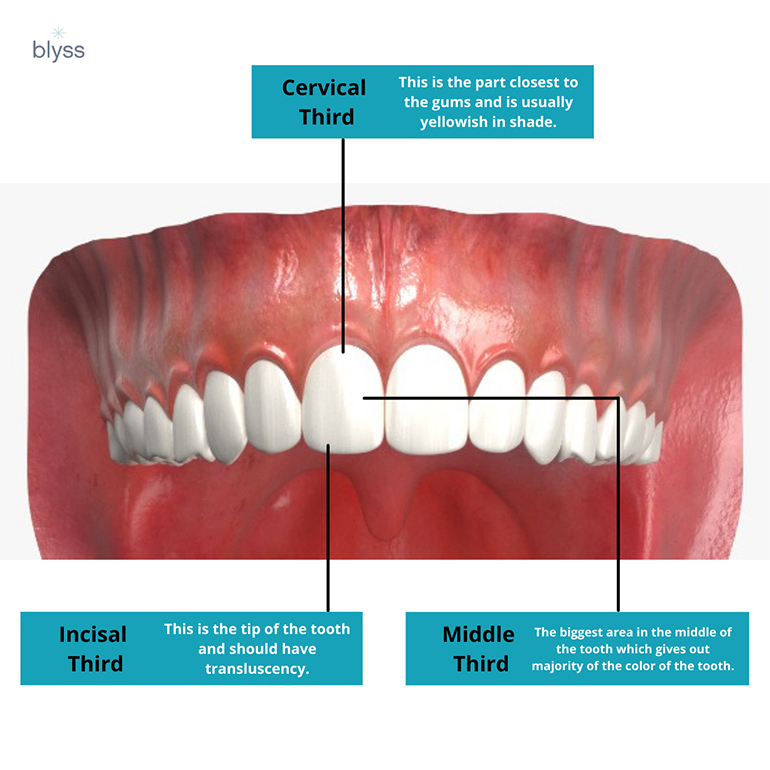
For a more natural look, the color of your veneers should closely resemble the natural color structure of your teeth.
Age is also a factor in choosing the right color for your veneers. When we are younger, our permanent teeth start out whiter and more translucent due to a thicker layer of enamel. As we age, the enamel or the outer layer of the teeth thins out exposing the dentin which has a more yellowish shade.
Therefore, the older we get, the more yellowish or gray our teeth become. It might look unnatural if you get super white porcelain veneers if you are in your 50’s and 60’s. It would be better to consider natural teeth color with a slight shade.
Who really decides on what shade to get for your veneer? This is totally up to you, but your dentist should be able to show you how it looks on you through trial (provisional) veneers. Then you can critique and give your feedback before the dentist makes the permanent veneers.
D. What Veneer Shape Should You Get?
The shape of your teeth plays a big role in your overall appearance. The most common shapes of veneers are oval, triangular, and square teeth.
Oval or rounded teeth often give out a more feminine, softer, and youthful appearance. Square or sharp-angled are often associated with a more masculine, stronger, or more matured look. Triangular-shaped teeth are associated with a softer and more “Hollywood” look.
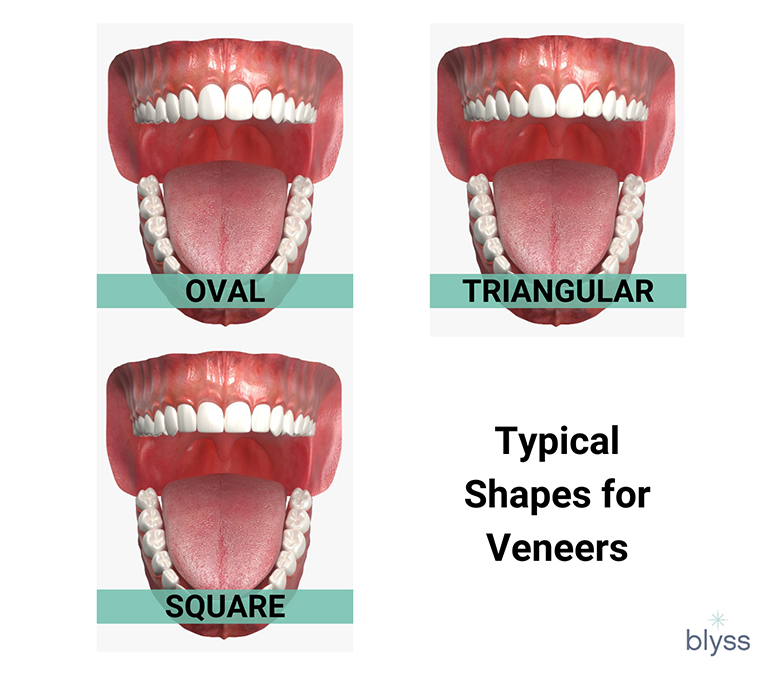
The shape of your veneers can greatly affect how you look. Discuss with your dentist the most appropriate shape for you.
However, it is very important that you do a “trial fitting” of your chosen shape to see if it will compliment your face and personality. Ideally, your dentist should be able to do the following:
- Complete diagnostics. Get complete diagnostics of your teeth, which include photos, molds, and X-rays.
- Wax mock-up. From your molds, your dentist will then fabricate a cast to do a wax mockup. This will be the initial “design” of your teeth.
- Temporaries or provisionals. Once you both agree on the wax mockup, the dentist will fabricate temporary or provisional veneers.
- Fitting. The dentist will “transfer” or fit the temporary or provisional veneers directly on your natural teeth. Depending on your teeth, you can now have a better idea of how your veneers would look on you.Now, don’t expect it to give you that perfect smile yet! Holes, gaps, or bubbles might appear on this step. This just might show the areas on your natural teeth that need to be shaved off in order to place the veneer.
- Adjustments. At this point, don’t be afraid to tell your dentist what you think. You can have your dentist modify specific details on the provisionals that you didn’t see on the wax mockup. This includes the shape of the teeth or how angled or bulky they should be.
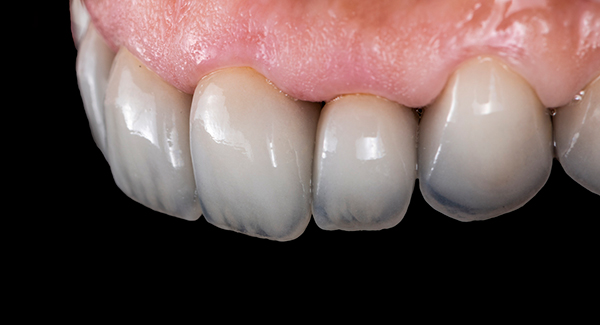
Did you know? Some patients add a tiny hint of imperfection or misalignment so that their veneers would be more natural-looking.
E. How To Choose The Correct Size Of Veneers?
Aside from the color and shape, size is also a factor to consider. Choosing teeth that are too wide can make you look like a horse or too long can make you look like a bunny. Along with trying out the shape, you should also pay importance to the size.
Smaller or shorter teeth may give you an older appearance. This is because as we age, we tend to grind our teeth naturally. This is also why it appears squarer or more angled as we age.
Getting your teeth too long or too big might also alter your bite and might cause trauma to your temporomandibular joint (TMJ) or the joint between your upper and lower jaw.
This is why it is very important to address other problems in your mouth properly. You want to make sure that your bite is stable so the dentist can establish the “correct” size of your veneer.
“Jason wanted to get a full smile makeover. He had stained and crooked teeth and was shopping around for the best deal. He thought all the US prices were too expensive so he went to Mexico and even shopped for the cheapest price for veneers in the area. After the trip, he showed up at a party to brag about this new set of teeth. Immediately, his friends noticed that his teeth were a little small. It made him look older.
The bottom line: you get what you pay for. It’s best to invest in a good dentist for dental veneers.”
5. How Can You Assure That You Are Getting The Best Quality Dental Veneers?
- Read patient reviews. Research about your dentist and look for real patient reviews. If you can find someone who has had their veneers for over 5 years, you can consider their dentist too.Don’t fall for everything you see on social media and consider looking for real actual patient reviews. Not all good-looking teeth are healthy teeth, and whiter teeth don’t mean healthier teeth. Some social media photos are photoshopped too!
- Natural-looking is best. Consider finding natural-looking veneer cases instead of solid whiter teeth. Not all porcelain is the same. Cheap-quality veneers don’t give out high translucency and could often look like Chicklets. Low-quality materials also fracture or break more frequently.
- You get what you pay for. Don’t be fooled by promos or offers that sound too good to be true. These are often red flags for poor quality work and might cost you more if you’ll have to repeat your veneers or further problems arise.
6. How Much Do Veneers Cost?
The cost of veneers varies depending on the chosen material and the number of teeth or units. This could mean having a minimum of six teeth up to 20 teeth.
Some people start with their six upper teeth just to try it out or just want a “new” smile. This means having veneers on your upper right canine up to the upper left canine because these teeth commonly show when smiling. This could also reach your premolars depending on the width of your smile.
Naturally, our lower teeth become more visible as we age due to the changes in our facial features. This means lower teeth might show more when you smile and talk.
People who also have grinded teeth, due to other factors like TMJ disorders, commonly have veneers done on both upper and lower teeth to restore the “natural” height or size of the teeth. This means having veneers on from your right second premolar to your left second premolar on both upper and lower jaw.
So, the more teeth or units you will need, the more that it will cost you. To give you an idea of the cost of veneers, here are the average prices per unit depending on the type:
| Cosmetic Dentistry Procedure | Average Price in San Diego (per tooth) | Blyss Dental Price |
|---|---|---|
| Composite Veneer | $850 | $890 |
| Porcelain Veneer | $1,800 | $1,852 |
| EMAX Veneer | $1,800 | $1,852 |
| Zirconia Veneer | $1,800 | $1,852 |
7. How To Take Care Of Your Veneers?
Veneers can last from 3 to 15 years depending on your chosen material and how well you maintain it. Here are some things that your dentist might need you to do (in case he forgets to mention it!):
- Visit your dentist regularly at least every six months. Your dentist will need to assess your teeth by updating your diagnostics from your last visit. This could include taking photos of your teeth or taking panoramic x-rays. If you feel something is wrong with your teeth, it’s best to have them checked right away and not wait for that 6-month period.
- Regular cleaning or oral prophylaxis at least twice a year. However, don’t be afraid to come back to your dentist when you feel that plaque or stain starts to build up again even if it has been only a month.
- Wear a night guard or sports guard. Have a night guard fabricated to wear at night or a sports guard if you are in contact sports. This will protect your veneers and teeth from too much force that might cause trauma.
- Choose what you bite. Avoid biting off directly with your front teeth especially on foods like corn on a cob, apples, barbecue, burgers, and nuts, or anything that requires you to bite hard. You can chop it off into smaller pieces before putting it in your mouth.Always remember that if your natural tooth can break off, what more would the replacements be if you won’t be careful with what you bite.
- Maintain good oral hygiene. Brush your teeth at least twice a day and floss correctly every after brushing. Jet water flossers are also a good investment if you don’t want to keep buying traditional floss.
Common Questions Asked About Veneers
Are dental veneers painful?
No. Before tooth preparation, your dentist will numb off your teeth first by applying gel anesthesia before putting the anesthesia itself. This might sting at first but once the anesthesia is in, you don’t need to worry about pain anymore.
How long will the procedure take?
After thorough treatment planning, the first appointment for the veneers will be tooth preparation/reduction. This will take a minimum of 3 hours depending on the number of veneers.
How long before I get my veneers?
With composite veneers, you will get results right after the first appointment. With porcelain veneers, you’ll need around 3 to 4 appointments. (Note: Depends on the clinic’s protocol.)
What would my teeth look like after you reduce them?
Your teeth will have spaces in between and would look a little tapered compared with the natural tooth. BUT, no need to worry about other people seeing you because your dentist would give you temporary veneers while waiting for the actual veneers.
Can I eat while wearing temporary veneers?
Absolutely! But you must avoid eating sticky and hard food because you might break your temporaries. You also need to avoid anything too cold or hot because it might trigger sensitivity.
Will I be able to eat with veneers?
Yes! But you have to be extra cautious about putting too much force on your veneers. Avoid biting hard food like apples, corn on a cob, and burgers. You can always cut them into small pieces before eating.
Do you have to take my teeth out when getting veneers?
No. Your dentist might only need to reduce PART of the topmost surface but it’s still your natural tooth.
Would people know I have veneers?
This is totally up to you! This will depend on the color and shape that you will choose. Remember, the whiter or more solid the color is, the more that it would be noticeable.
How long will veneers last and do I need to change them?
Well-maintained veneers should last 5-15 years depending on the type and quality of the installation. This means having consistent dental check-ups and maintaining a good dental regimen at home.
I changed my mind and don’t want veneers anymore, what can I do?
Unfortunately, once your dentist has reduced your teeth, you can’t go back anymore. That’s why planning with your dentist is very important to avoid regrets. If you are not happy with the results, your dentist could only change the veneer (change the material, shape, and color).
What is gum recontouring or “gum lift”?
Some teeth appear different in size because of uneven gum levels. With a numbed gum, your dentist will “reshape” your gums to have more teeth symmetry and uniformity. This will improve the overall aesthetics of your teeth.
Will I have bad breath when I get veneers?
If your dentist is not meticulous, excess cement might be left out after cementing the veneers. This will cause gum problems which could harbor bacteria and give out a foul smell. Make sure that you can properly floss all your veneers and maintain good oral hygiene.
How many veneers should I have?
You can start with at least two teeth to have a new smile. You can also check the width of your smile to consider the number of veneers. This could mean 6-12 teeth per arch depending on your preference and needs.
Conclusion
Getting veneers is an absolutely effective way to transform your smile. It will truly give you that extra level of confidence and personality.
It is a journey to have veneers made. But I do hope that you are now fully equipped with enough knowledge to help you on your journey towards the perfect smile – from choosing your dentist to selecting the right type of veneers for you.
At Blyss Dental, we help you every step of the way. Using the information I discussed in this article, you can surely avoid issues and hassles the first time you go to your dentist. With that, you can get the best veneers that fit your needs.
I’m sure that you have more questions in mind which are more in-depth and technical. Blyss Dental offers a complimentary consultation. Make sure to list your questions down and book an appointment with us. I would be glad to help you understand more.
